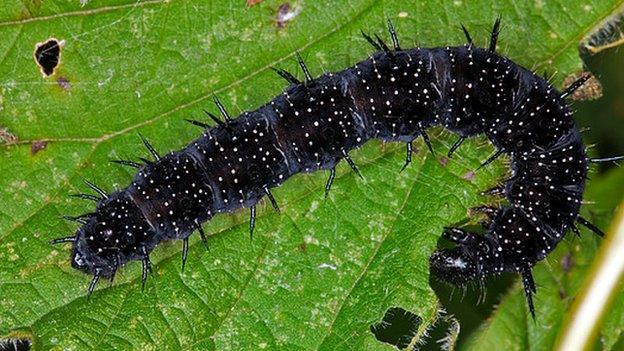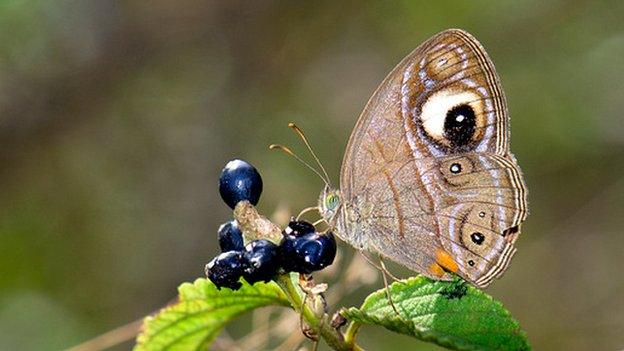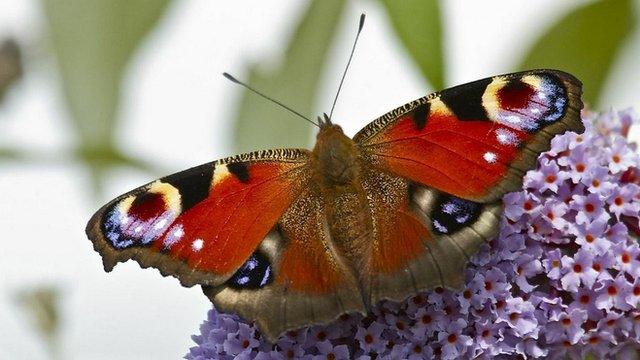Do butterfly wing patterns really mimic predator eyes?
- Published

The warm, dry weather since the spring has provided ideal conditions for the peacock
A bumper crop of spikey black caterpillars have appeared on the nation's nettles this summer.
Clad in velvet coats peppered with white dots, the creatures have been sunning themselves and munching through the weeds in remarkable numbers prompting a flurry of enquiries and reports to the charity Butterfly Conservation.
They might not be so familiar in this form but the insects will grow up to be arguably Britain's most colourful and recognisable butterfly - the peacock.
As they prepare for their annual Big Butterfly Count, experts at the charity are predicting a bonanza of the butterflies.
Last year, the species surged to third position in the survey which asks the public to record how many butterflies they see in 15 minutes of sunny weather.
Following on from this success, peacocks emerged in good numbers after their winter hibernation according to Butterfly Conservation's Surveys Manager Richard Fox. The warm, dry weather since the spring has provided ideal conditions for breeding, egg-laying and the development of caterpillars.
"They need to be warm in order to feed and grow and digest their food. Everything about their lives is dependent on warmth from the surrounding world," explains Mr Fox.
In recent weeks the caterpillars have been entering pupation so the mature butterflies could turn up just in time for the count.
"It could really be the year of the peacock," says Mr Fox, noting that the two species at the top of the ranking in all previous surveys, the small white and large white, have been seen in relatively fewer numbers this year.
The rich burgundy wings decorated with cream, yellow, black and iridescent violet accents mark peacocks out as one of our brightest species and they are best known for the eyespots they share with their namesake birds.

The spiky black peacock caterpillars can be found nestling on the leaves of nettles

The conspicuousness of the colourful patterns could be enough to put off potential predators
But according to Dr Martin Stevens from the University of Exeter, everyone's favourite pub fact about these markings could be wide of the mark.
The traditional explanation of these patterns is that they frighten off anything looking to eat the butterflies by mimicking the eyes of another predator. This would certainly benefit the insects which are particularly vulnerable to attack during their winter dormancy.
Scientists have so far presented evidence that chickens, blue tits and mice alike can be frightened off by the butterfly, but the jury is still out on whether eye mimicry is the key factor.
"For all butterfly and moth eyespots, they have long been assumed to mimic eyes without there being objective scientific evidence that this is true," explains Dr Stevens.
The theory that the patterns simulate eyes has persisted since the early studies of 19th Century naturalists but do the brightly coloured, high-contrast rings really look like predatory eyes?
In a review published in the journal Current Zoology, Dr Stevens and Prof Graeme Ruxton from the University of St Andrews analysed the evidence so far but found nothing conclusive.

The problem remains that it is difficult to separate possible eye mimicry from the rest of the peacock's defensive arsenal: when threatened the insects emit a rustling hiss and briefly flash their bright wings.
Dr Stevens argues that just the conspicuousness of the colourful patterns could be enough to put off potential predators.
"Human perception may be misleading as a way of interpreting animal markings because many animals have very different visual systems and perception to us," says the ecologist calling for further study.
"We really need to try and understand how predators respond to eyespots and whether they categorise them as real eyes."
One thing's for certain, if you get outside in the UK over the next couple of weeks you're very likely to come eye-to-conspicuous-circular-marking with a peacock butterfly.